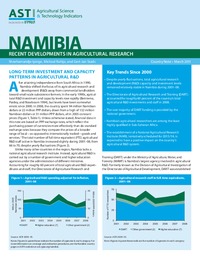Authors:
Ipinge, Sheehamandje; Rahija, Michael; Stads, Gert-Jan
Year:
2011
Publisher
International Food Policy Research Institute (IFPRI)
Back to:
Agricultural R&D in Namibia differs from most other African countries in several key ways. The country’s agricultural R&D intensity ratio is nearly four times the African average, its R&D agencies are relatively well-funded by the national government, and foreign donors play only a marginal role in financing agricultural R&D efforts. In 2008, the country invested 94 million Namibian dollars or 22 million dollars (both in 2005 PPP prices) and employed 70 FTE agricultural researchers.
Despite these positive indicators, the major constraint to effective agricultural R&D is the reality that Namibia’s agricultural scientists are among the least highly qualified in Africa. The country’s universities currently do not offer PhD programs in agricultural sciences, so scientists seeking training beyond the MSc level must travel abroad. Notwithstanding numerous government-funded training efforts that have improved average qualification levels in recent years, Namibia still lacks a critical mass of PhD-qualified scientists, which is crucial to both producing effective research results and securing future R&D funding.
DART is currently the country’s principal agricultural R&D agency, accounting for roughly 60 percent of its agricultural R&D staff and investments. Being a directorate under MAWF, DART is constrained in its ability to offer competitive salaries and attract and retain well-qualified researchers. Moreover, even though DART generates substantial funding through the sale of goods and services, these funds are channeled back to the Treasury, leaving little incentive for the directorate to develop this income stream. The recent Cabinet approval of the creation of a national agricultural research institute or NARI, tentatively scheduled for 2013/14, is set to change all this. As a state-owned company the proposed NARI will be more client-driven, have the flexibility to offer higher salaries, and be able to generate funding through its own activities. All these factors are likely to have a positive effect on future agricultural R&D investment levels and staff development in Namibia.

